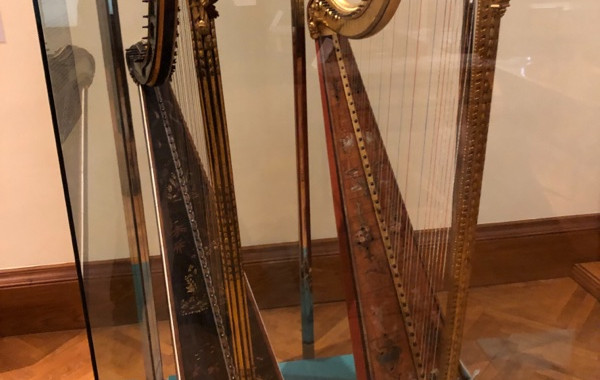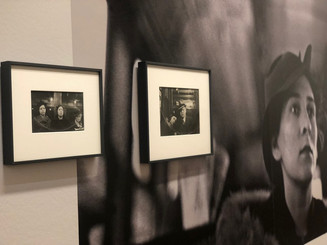Vienna, Austria
To put it quite frankly, we have failed at Vienna. Our colds (I’m on the mend, but Josh has now succombed and is having a harder time than I did) and the cold, windy, rainy weather has played a big part.

This city is called the ”City of Music” because more famous composers lived here than any other city, but it could just as easily be called the “City of Museums.” There are tons of museums (many dedicated to said composers). There is a vibrant arts culture (classical concerts, opera and ballet everywhere). Unfortunately, we have barely even scratched the surface of all there is to see and do.
Yesterday morning we made an attempt to hit as many museums as we could. We started at the Hofburg Palace - former imperial palace of the Hapsburg dynasty, originally built in the 13th century. The palace now houses the current President of Austria's offices, as well as numerous museums.

We visited the Imperial Treasury first. Here, the jewels and treasures of the Hapsburg empire are on display - including both the Hapsburg Crown Jewels and Crown of the Holy Roman Empire.
Josh was most interested in the Holy Roman Roman Empire section. The Imperial Crown of the Holy Roman Empire (its full name) was built in 10th century. It is unusual among crowns because it is shaped like an octagon rather than a circle. Decorated with 144 precious stones and as many pearls, the crown’s base is made with 22 carat gold and the stones are connected via gold wiring which creates the illusion that light is shining from within the crown.

Next, we made our way to the huge Museum of Art History. It was extremely crowded (thankfully, we bought our tickets at the treasury and didn’t have to wait an hour in the ticket line). To be honest, the crowds kept us from really enjoying this museum and we left after seeing only a few of the permanent exhibitions.
One of the most famous paintings in this museum is Raphael’s The Madonna del Prato. Painted in 1506, the work features Mary with baby Jesus and baby John the Baptist. Mary is dressed in a brilliant blue and red garmet, which symbolizes (blue) the church and (red) Christ’s death.

Next, we made our way through Maria Theresa‘s Plaza to the Imperial Crypt that houses the remains of the Hapsburgs, including Maria Theresa. Remember, I mentioned her in my last blog post, the Lady King of the Hapsburg Empire. We learned a lot more about her yesterday.
Appreciated among Austrians as a patron of the arts, Maria Theresa was the last ruler of the House of Hapsburg and, for the most part, successfully defended the Empire during her 40 year reign. As I mentioned yesterday, she had 16 children (the most famous of which was Marie Antoinette, Queen of France).
Maria Theresa was often literally birthing children at the same time she was making important military and political decisions. Despite her terrible position on Protestants and Jews (even more hateful than most of her contempories), I really enjoyed learning about her.

My favorite detail was that she was kind of a control freak in regard to her children. When they were children, she would often make them put on musical performances for the residents of the city. Setting up a stage outside the palace, she would direct the children in Opera and musical performances almost nightly in the summertime.

When they were adults, despite the majority of the ten who survived to adulthood holding positions of extreme world power (two Queens - of France and of Sicily -, two Austrian Emperors, three Duchesses in the Holy Roman Empire, a Governor of Milan and a Grand Master of the Teutonic Knights), Maria Theresa wrote to each of them weekly to criticize them and offer (unsolicited) advice.
She often berated her children via letter for being lazy, disorganized and not practicing their French. In Marie Antoinette’s case, Maria Theresa often chastised her for being too extrvagant and for not having children. Which sounds exactly like my own mother (haha, I kid!)

Once we finished with these museums it was getting close to dark and the weather was still pretty gross. We still had another dozen or so museums on our list things we wanted to see, but time was just not on our side. We ended up going back to the hotel for a rest with plans to go back out - but ended up just ordering UberEats Thai takeout (globalism at its best) and calling it an early night.
Our intention had been to attend this event that the Government sponsers at the Vienna State Opera. Basically, on special occasions, they will stream a live opera performance on a huge screen outside the Opera house for the public to view for free. We were disappointed but we both really needed to rest up for today - our very last day.
Our morning started with a plan to go on another free walking tour of the city. However, the tour group was huge and over the years, we’ve found the bigger groups end up being terrible tours (to many people talking, you can’t hear the guide, you can’t go inside anywhere because the group is too big, etc. . .) so we left.

There were still so many museums we wanted to visit, anyway. So, we didn’t feel too bad about not getting a city tour. Josh and decided to split up for the rest of the morning to follow some of our individual interests.
Josh headed toward the Weltmuseum to see the collection of historic musical instruments and the Imperial Armory back in the Hapsburg Palace.
He was impressed with the collection of armor in the Armory museum. It was the widest and most thorough collection he has seen.

In the Weltmuseum he saw the instruments played by Maria Theresa‘s children during their forced summertime performances, as well as, Beethoven‘s childhood clarinets, a piano Mozart played on Christmas Eve in 1781 at the Hofburg Palace and a set of harps owned by Marie Antionette before moving to France.
I went to the Albertina Museum - an art museum which, among its permanent Picasso, Degas, Munch, Richter and Chagall collections, is hosting a big temporary Monet exhibit through January 6, 2019. Among the Monet collection was the famous 1887 piece, Young Girls in a Rowing Boat, as well as, some of his lesser known water lillies, landscapes from his time in Paris many of his Japanese Bridge paintings from his later years.

My favorite was a piece I had not heard of before, Camille Monet and a Child in the Garden, done in 1875. It’s an impressionist piece of his first wife, Camille, at their home in France and features virbrant reds and greens. It was stunning.

I also enjoyed the photography exhibit on Helen Levitt’s work. Helen Levitt was an American photographer from New York whose work on display spanned from the 1940s through the 1980s. A few of my favorite pieces are below.
After meeting back up for lunch, Josh and I headed back to the hotel to rest up for tonight’s festivities.
Tonight - in the style of Austrian Princess and French Queen, Marie Antionette, - we are living it and being extravagant at at a New Year’s Eve Ball! A real ball. In a real palace. I’ll post another blog with ball pictures tomorrow before we head home!




















Comments